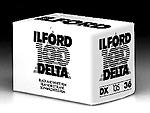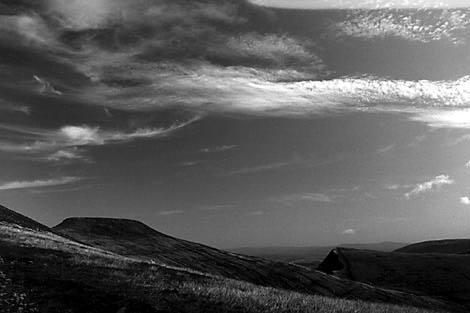

I've used it in all sizes from 35mm to 4 x 5" for the vast majority of my black-and-white work, only changing to HP5 in low light conditions or Pan F if I needed the finest grain.
But I think all that's going to change, because IÕve discovered Ilford 100 Delta. True, it's been around for a little while now, but I've been carrying out some tests on it for the last twelve months and the results have brought me to the conclusion that it really is an excellent film - a worthy successor to FP4.

The reason for this exceptionally fine grain is the way that the emulsion is formulated. It's based on IlfordÕs patented 'core shell' grain technology, where each silver halide crystal in the emulsion consists of three separate layers. At the centre is the core layer of silver iodide, which is responsible for controlling the speed of the film. Next to this is a layer of silver bromide for development control. It's this layer that results in improved granularity in the negative. Finally, the outer layer of silver bromide ensures that the film develops quickly.
The shape of these Delta silver halide crystals is more symmetrical than that of crystals in conventional emulsions. This substantially reduces the grain size, giving better picture quality. Conventional black-and-white films are usually coated with two layers of emulsion, each slightly different. But in 100 Delta these layers are integrated and coated as a single layer. This results in sharper negatives with more sparkle that you get in a two-layer emulsion.
The two integrated emulsions in 100 Delta interact with each other to give improved speed-to-grain ratio of the film, giving finer grain and higher film speed.
With 100 Delta you can push it a stop - to ISO 200 - without too much loss of quality, but that's about it. However, I've always been of the opinion that if you want a higher film speed you should use a faster film. And with Ilford's companion for Delta 100, Delta 400, you have an equally good film that's two stops faster. On the over-exposure side, Delta 100 behaves quite reasonably. You can rate it at ISO 50 and cut the development time a little or use a higher dilution, and the results are excellent. Though to be honest, shadow detail at the normal rating of ISO 100 is so good that I haven't found it necessary to down-rate the film.

It handles contrasty lighting situations extremely well, maintaining good shadow detail without allowing the highlights to clog. This, in my view, makes it the perfect film for landscape work where you need to maintain detail in the clouds without losing it in the shadows.
When I started testing the film I decided that I would keep one factor unchanged to give some sort of yardstick by which to evaluate the results. So I stuck with my long-term general purpose developer, Microphen. And I must say that at the recommended development time of 8 minutes at 20 degrees C (68F) it does a superb job. It produces easily printable negatives from a wide range of subjects when rated at its recommended ISO 100.
A development time of 9 minutes at 20C, as recommended by Ilford gives good results, but these are improved if you rate the film at ISO 64. Just that two-thirds of a stop seems to make all the difference.
For very high contrast subjects, diluting the developer 1+3 and developing for 14 minutes at 20C gives even better highlight control. I found this dilution highly suited to landscape work when I wanted to retain maximum highlight detail in clouds without sacrificing shadow detail.
To achieve this it's advisable to rate the film at ISO 50 or even 40 to ensure maximum details in the shadows. The diluted developer then controls the highlights to prevent clogging.
Paterson recommend two development times, 6.5 minutes for normal contrast and 10.5 minutes for high contrast, both at 20C. If you go for the higher contrast, I suggest you rate the film at ISO 200 instead of ISO 100.
Because you use Rodinal as a highly diluted solution - typically 1+25 to 1+50, though you can go as high as 1+200 for some films - it produces maximum edge effect, which is sometimes called high actuance. Added to this, the image is built up very slowly and to only a shallow depth in the emulsion. This surface development, as it's called, results in a high degree of image sharpness and helps the compensation effect of the developer.
Combine all this with the already very sharp characteristics of Delta 100 and you have a winning combination.
There is a down side, though. ThereÕs no way that Rodinal can be called a fine grain developer. It retains the grain structure of the film, to be sure - and as IÕve pointed out, in Delta 100 this structure is inherently fine - but it doesn't reduce it. Nor, to be fair, does it make it any worse. But if you want fine grain negatives, stick with Microphen.
In their data sheet about Delta 100, Ilford recommend using Rodinal at a dilution of 1+25 for 7 minutes at 20C, but my tests so far suggest that, for my kind of photography at least, 1+50 for 11 minutes at 20C produces better results.
In the instructions that come with the film, Ilford give recommendations for a whole lot more developers, but as I haven't tried them and I don't see the point of repeating them all here, I won't.
To sum up, then, I've always said that it would take a lot to get me away from FP4 as my standard film, and the fact that I've used it for well over twenty years (FP4 was introduced in 1968), and FP3 before it, shows how highly I regarded the film. But on the results so far, Delta 100 seems to be the film that I'll be happy to use as my new standard.
The only thing I would say, though, is that it isn't quite so forgiving as FP4. You'll still get excellent results from the film if you're not absolutely accurate with your exposure or development time, but the extra care taken in getting exposure and development spot on really does pay off in terms of improved results.
The author's e-mail: [email protected]
Return to August contents